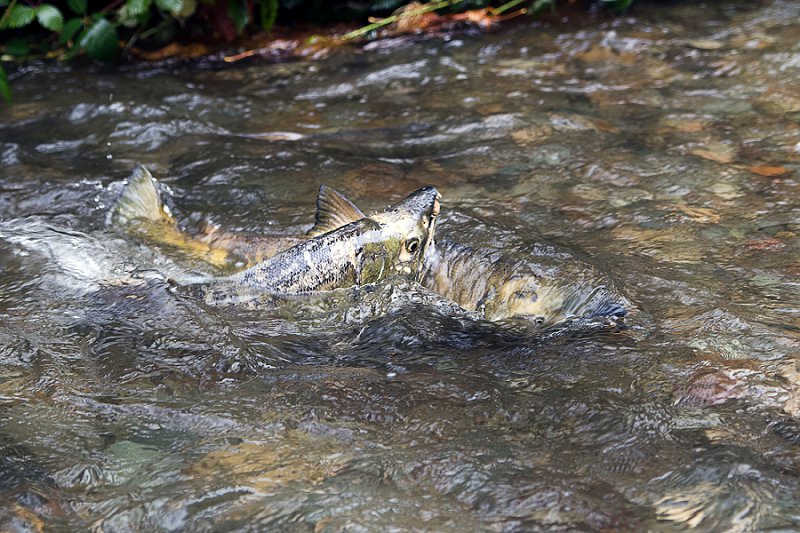Thank you to Great Peninsula Conservancy for submitting this post.
Hidden in the quiet sanctuary of Grovers Creek, in western Washington State, is a grove of spectacular 200-year old spruce, cedar, hemlock and fir trees, a quiet stream that is home to beavers, and wandering bears feasting on the fall salmon run. Great Peninsula Conservancy led a community campaign that brought together birders, hikers, tribes, and community group and successfully raised funds to purchase 200 acres of this natural wonder in 2015. Now conserved forever, Grovers Creek Preserve ensures these wild creatures will always have a place to call home. Our work to save these lands, and others nearby, also offers an opportunity to expand regional trails to provide a place for people to enjoy the beauty of nature today and forever.
In 2017, Great Peninsula Conservancy again collaborated with local partners to expand Grovers Creek Preserve by an additional 80 acres. The preserve, located near the town of Kingston, is about 16 miles northwest of Seattle across the Puget Sound. Much of Grovers Creek Preserve was previously owned by Pope Resources, and was managed as timberland for Douglas fir. Other portions of the preserve were owned by the Helton and Kawahara families, who generously donated or sold portions of their land to Great Peninsula Conservancy. The creation and expansion of Grovers Creek Preserve is part of the wider Kitsap Forest and Bay Project—a collaborative effort that has successfully preserved over 4,000 acres of forestland in the northern Kitsap Peninsula that contains diverse habitats, as well as wildlife and trail corridors.
“Grovers Creek Preserve is a magical place of big trees, bears and beavers that reminds us of the Kitsap Peninsula of long ago,” commented Sandra Staples-Bortner, Executive Director of Great Peninsula Conservancy. “We are delighted to be working with the many project partners to save this land for all time.”
Grovers Creek Preserve abuts Kitsap County’s North Kitsap Heritage Park, and is at the center of a continuous forest corridor spanning nearly 1,700 acres in northern Kitsap Peninsula. It is home to black bears, bobcat, cougar, and coyote, as well as over 60 species of birds, including federal species of concern like Bald Eagle and Olive-sided Flycatcher. It will be a critical link in the future Sound to Olympics Trail, which aims to create a continuous regional trail across Kitsap County that connects the existing (and highly popular) Mountains to Sound Greenway and the Olympic Discovery Trail. The Grovers Creek Preserve will provide a place for families to explore these natural wonders on foot and bicycle.
A special part of this preserve was set aside as a core wildlife-only area. Kitsap Audubon Society and Seattle Audubon Society generously supported the project to protect a rare grove of 200-year-old Sitka spruce, hemlock, cedar, and fir in the hopes that Marbled Murrelets—a small seabird that lays its single egg high up in old growth conifers—will one day nest in this old growth forest. Marbled Murrelets, listed as threatened under the Endangered Species Act, have been observed in nearby Port Madison Bay and the larger Puget Sound.
In addition to its importance to birds, Grovers Creek Preserve also safeguards over 2.4 miles of fish-bearing stream, which is critical habitat for threatened steelhead, as well as cutthroat trout and coho salmon. Wetland pools in Grovers Creek Preserve release a year-round flow of clean cold water, which is critical to maintaining water levels in the streams throughout the dry summer months.

Support for protecting Grovers Creek Preserve came from the state of Washingtonʻs Wildlife and Recreation Program, Kitsap Audubon Society, Seattle Audubon Society, Kitsap County, Suquamish Tribe, a bequest from Virginia Cowling, a donation of land by the Helton family, and many other generous individuals who contributed to Great Peninsula Conservancy’s capital campaign.
Editors Note:
For more about projects in this area, see: Conserving Forest and Shoreline on the Kitsap Peninsula.
For more about the Marble Murrelet, see The Mysterious Marbled Murrelet.
